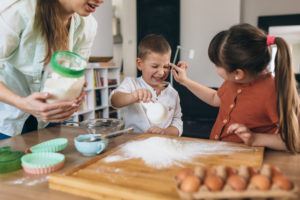Tips to help kids navigate a routine change in school holidays
 Getting ready for the school holidays can be both exciting and challenging. The pressure of having to be somewhere is now pressure to adjust to a different routine and a period of time with lots of different experiences.
Getting ready for the school holidays can be both exciting and challenging. The pressure of having to be somewhere is now pressure to adjust to a different routine and a period of time with lots of different experiences.
Our Occupational therapists and Speech pathologists have put together some ideas to help you get to the other side of the school holidays feeling ready for the term ahead.
Children thrive on a few basic concepts:
- Knowing what the plan is
- Feeling safe, heard, and understood
- Sharing moments with people they care about
Preparing for holidays and sharing the plan with your kids helps holidays run smoothly.
Calendars & Schedules
 Use your family calendar or make a visual timeline to help children anticipate events. Something they can see and point to can be especially helpful for children with autism or those who are non-verbal (Here is a blog on calendars that might also be useful)
Use your family calendar or make a visual timeline to help children anticipate events. Something they can see and point to can be especially helpful for children with autism or those who are non-verbal (Here is a blog on calendars that might also be useful)
Talk about what will happen
Prepping children for holiday events helps reduce worry/anxiety. Discuss the upcoming celebrations, the people they might see, and the activities that they will do. You can even place a picture of the activities on your calendar/schedule. This helps children with speech or language delays understand what to expect.
Plan for tough moments
There will always be tough moments, practice activities you can do with your child to help them feel okay (regulated). It is important to practice when they feel calm and alert. Here are a few ideas:
- Big breaths – finding a way to deep breathe with your child can help calm their bodies e.g. dragon breaths, box breathing, candle breathing
- Body input – hugs, squeezes, tickle backs, hand massages/tickles, pressure through shoulders
- Connection – acknowledge the challenge, sit in the moment with your child
- Check out our blog here for more information on supporting children’s regulation
Activities to support following the plan
Plans can be tricky to follow, but there are some things you can do to support those plans moving smoothly:
- Holiday Activities for Following Directions: Engage children in simple holiday-related activities that require following directions. For example, making a holiday craft or decorating a tree can include steps like “glue the ornament,” “hang the decoration,” or “cut the paper.”
- Multi-Step Directions: For older children, practice multi-step directions in the context of holiday preparations (e.g., “First, you need to put on your coat, then we’ll go outside to play in the snow”).
Support your kids to feel safe, heard and understood through the holidays allows their bodies to relax and recharge ready for another school term. As parents, we can do this by:
Managing Sensory Overload
The hustle and bustle of the holidays can be overwhelming for children with sensory processing challenges. Create a quiet space where they can retreat if they need a break. Have a sensory kit (and spare set of clothes) with you to support regulation. Ensuring that children are comfortable allows them to be more engaged in communication.
Worries and Dreams
Talk about what they might be worried about in the plan or what they really want to do over the holidays. Just voicing this can help kids feel safer.
-
Back up plans
Finding these out allows you to have a “feel okay” plan just in case a worry comes up
-
Role-playing
Practice social scenarios like greetings, thanking people, or sharing gifts if this is something your child might be worried or unsure about. This helps children practice expected social behaviors, such as eye contact, taking turns in conversations, and responding appropriately.
AAC Devices
If a child uses an augmentative and alternative communication (AAC) device, incorporate holiday-related vocabulary into the device to encourage its use during the season.
- Low-Tech: Picture cards, communication boards, or gestures, PODD books
- High-Tech: Tablets, speech-generating devices, or eye-tracking systems.
Over the holidays, we all want to feel connected and kids are no different, finding opportunities for shared moments, creates connection, safety, and new memories to share with others.
This can be done through:
Interactive Games: Play games like “I Spy” with holiday-themed objects, which helps with vocabulary building and can strengthen understanding of prepositions and concepts like colors, shapes, and locations.
Crafts and Art Activities: Encourage the child to describe what they’re doing while crafting. Use simple prompts like “Can you tell me what you’re making?” or “What colors did you choose?” to boost their expressive language skills.
Recognizing Different Holiday Traditions: Be mindful that not all children celebrate the same holidays. If a child’s family follows different traditions, you can talk about those holidays as well, promoting inclusivity and allowing children to share their own experiences.
Facilitate Conversations: Holidays often involve family gatherings. Encourage children to participate in conversations by modeling good communication practices. For example, you can ask open-ended questions that allow children to elaborate on their thoughts.
- Build the words they know so they can share their stories with their wider family and friends:
-
- Themed Vocabulary: Holidays provide a rich opportunity to introduce themed vocabulary. For example, you can introduce words related to a specific holiday (e.g., Christmas: tree, ornament, Santa, etc.). Use holiday songs, crafts, and stories to encourage new word learning.
- Storytelling and Narrative Skills: Read books related to the holidays, and ask the child to recall the sequence of events or retell the story. This helps develop narrative skills and vocabulary comprehension.
By integrating these strategies, children can enjoy the holiday season while simultaneously building their communication skills, connection to family, and safety to try new things.
Enjoy the time together!


Written by Occupational Therapist Hanna Corfield & Speech Pathologist Libby Hall
